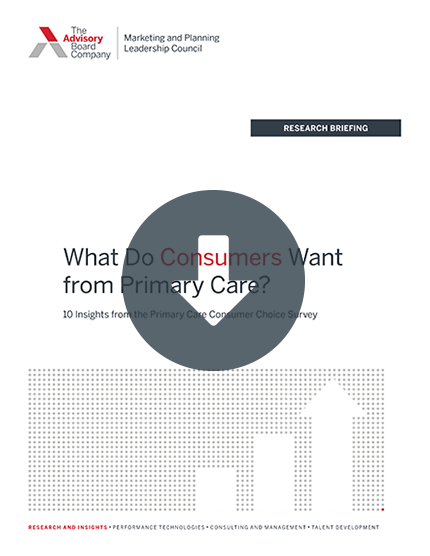Auto logout in seconds.
Continue LogoutPrimary care is central to most health systems' strategies, whether you're looking to drive downstream referrals or control costs. But a new analysis from the Health Care Cost Institute shows that this health system entry point may be changing. The analysis—which was based on data from Aetna, Humana, Kaiser Permanente and UnitedHealthcare—found that primary care physicians (PCPs) saw 18% fewer patients from 2012 to 2016.
Does your market have enough primary care providers? Here's how to tell.
What's driving the decline?
One driver of the decline is likely the PCP shortage, which the Association of American Medical College estimates will range from 14,800 to 49,300 doctors by 2030. While the PCP shortage isn't something most health systems can easily tackle, there are several additional factors worth exploring that may be further driving PCP visit decline:
- Advanced practitioners are playing a larger role
While primary care physicians are seeing fewer patients, the same cannot be said for advanced practitioners. Part of the reduction in visits to PCPs can be explained by an increase in visits to physician assistants (PAs) and nurse practitioners (NPs) providing primary care services. In fact, office visits for primary care to NPs and physician assistants PAs increased by 129% from 2012 to 2016, according to the same Health Care Cost Institute study.
Still, the increase in NP and PA visits accounts for only 42% of the total decline in primary care physician visits, so overall reduction in visits for primary care is taking place.
- Patients are a self-referring to specialists
Another potential explanation for the overall decrease in primary care visits is patients increasingly circumventing the traditional primary care-to-specialist referral process and instead directly scheduling appointments with specialists. This shift is supported by our Specialty Care Consumer Choice Survey, which found that 34% of respondents self-referred to a specialist. For some specialties, such as OB/GYNs, up to 47% of respondents self-referred.
- Patients are seeking care from alternative sites
Alternatives to traditional primary care, such as urgent care centers, retail clinics, and virtual visits, are on the rise. These on-demand options seek to meet consumer preferences for access and convenience, which our research has shown to be particularly important for driving patient choice around primary care. While access is preferred across age groups, younger patients may be more likely to turn to on-demand alternatives, with 50% of urgent care patients being between 18 and 44 years old. Further, a recent Kaiser Family Foundation poll found that 45% of 18- to 29-year-olds do not have a primary care provider. Instead, according to the report, millennials are turning to urgent care centers and clinics to meet their on-demand care needs.
How to respond
Organizations should work both to compete for patients self-referring to specialists and to better meet consumer preferences for primary care.
To capture self-referrers, progressive organizations are "retailizing" their service lines by engaging potential patients through symptom-focused messaging, cultivating a word-of-mouth strategy, providing fast access for select parts of the care pathway, and creating a targeted pricing strategy.
To meet consumer preferences, organizations can adjust current primary care practices or weigh investment in alternative sites of care, which may be better suited to provide quicker access and convenience.
Editor's note: The Growth Channel is published by Advisory Board, a division of Optum, which is a wholly owned subsidiary of UnitedHealth Group. UnitedHealth Group separately owns UnitedHealthcare.
Don't miss out on the latest Advisory Board insights
Create your free account to access 1 resource, including the latest research and webinars.
Want access without creating an account?
You have 1 free members-only resource remaining this month.
1 free members-only resources remaining
1 free members-only resources remaining
You've reached your limit of free insights
Become a member to access all of Advisory Board's resources, events, and experts
Never miss out on the latest innovative health care content tailored to you.
Benefits include:
You've reached your limit of free insights
Become a member to access all of Advisory Board's resources, events, and experts
Never miss out on the latest innovative health care content tailored to you.
Benefits include:
This content is available through your Curated Research partnership with Advisory Board. Click on ‘view this resource’ to read the full piece
Email ask@advisory.com to learn more
Click on ‘Become a Member’ to learn about the benefits of a Full-Access partnership with Advisory Board
Never miss out on the latest innovative health care content tailored to you.
Benefits Include:
This is for members only. Learn more.
Click on ‘Become a Member’ to learn about the benefits of a Full-Access partnership with Advisory Board
Never miss out on the latest innovative health care content tailored to you.

